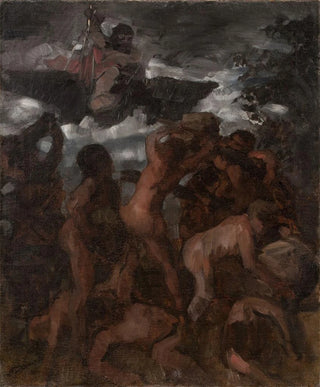Art print | Study for the Gigantenschlacht - Wilhelm Trübner


View from behind

Frame (optional)
The canvas "Study for the Gigantenschlacht" by Wilhelm Trübner is a piece that invites immersion into a universe rich in symbols and emotions. This work, created at the turn of the 20th century, evokes themes of struggle and confrontation, while highlighting the technical mastery of the artist. Through this art print, the viewer is transported to a vibrant scene where human figures, both powerful and fragile, seem to dance across the canvas, embodying an epic fight that transcends time and space. Trübner's work does not merely depict a battle; it also raises profound questions about the human condition, destiny, and the duality between strength and weakness.
Style and uniqueness of the work
Wilhelm Trübner's style is distinguished by bold use of colors and a dynamic composition. In "Study for the Gigantenschlacht," warm tones and striking contrasts give the scene dramatic intensity. The figures, although stylized, are imbued with poignant realism, with each gesture and expression capturing the essence of human struggle. Trübner's technique, blending Impressionist influences and elements of the academic tradition, creates a fascinating dialogue between movement and stillness. The forms seem to vibrate under the artist's brush, while the background, often blurred, emphasizes the importance of the characters in the foreground. This singularity makes the work a unique testament of its time, while remaining timeless in its message.
The artist and his influence
Wilhelm Trübner, an emblematic figure of the German artistic movement, managed to mark his era with his innovative approach and quest for aesthetic truth. Influenced by masters such as Gustave Courbet and the Impressionists, he integrated elements of these currents while developing his own voice. His work, often centered on themes of mythology and history, reflects a deep reflection on art and its role in society. Trübner was also a mentor to many artists of his time, contributing to the formation of a new generation of artists who knew how to s...

Matte finish

View from behind

Frame (optional)
The canvas "Study for the Gigantenschlacht" by Wilhelm Trübner is a piece that invites immersion into a universe rich in symbols and emotions. This work, created at the turn of the 20th century, evokes themes of struggle and confrontation, while highlighting the technical mastery of the artist. Through this art print, the viewer is transported to a vibrant scene where human figures, both powerful and fragile, seem to dance across the canvas, embodying an epic fight that transcends time and space. Trübner's work does not merely depict a battle; it also raises profound questions about the human condition, destiny, and the duality between strength and weakness.
Style and uniqueness of the work
Wilhelm Trübner's style is distinguished by bold use of colors and a dynamic composition. In "Study for the Gigantenschlacht," warm tones and striking contrasts give the scene dramatic intensity. The figures, although stylized, are imbued with poignant realism, with each gesture and expression capturing the essence of human struggle. Trübner's technique, blending Impressionist influences and elements of the academic tradition, creates a fascinating dialogue between movement and stillness. The forms seem to vibrate under the artist's brush, while the background, often blurred, emphasizes the importance of the characters in the foreground. This singularity makes the work a unique testament of its time, while remaining timeless in its message.
The artist and his influence
Wilhelm Trübner, an emblematic figure of the German artistic movement, managed to mark his era with his innovative approach and quest for aesthetic truth. Influenced by masters such as Gustave Courbet and the Impressionists, he integrated elements of these currents while developing his own voice. His work, often centered on themes of mythology and history, reflects a deep reflection on art and its role in society. Trübner was also a mentor to many artists of his time, contributing to the formation of a new generation of artists who knew how to s...






